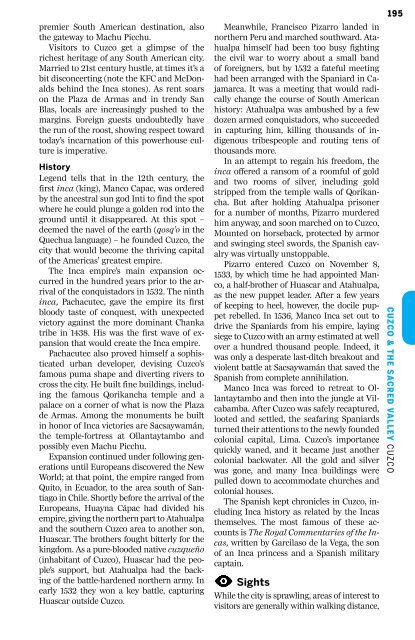peru-8-cuzco-sacred-valley
Create successful ePaper yourself
Turn your PDF publications into a flip-book with our unique Google optimized e-Paper software.
premier South American destination, also<br />
the gateway to Machu Picchu.<br />
Visitors to Cuzco get a glimpse of the<br />
richest heritage of any South American city.<br />
Married to 21st century hustle, at times it’s a<br />
bit disconcerting (note the KFC and McDonalds<br />
behind the Inca stones). As rent soars<br />
on the Plaza de Armas and in trendy San<br />
Blas, locals are increasingly pushed to the<br />
margins. Foreign guests undoubtedly have<br />
the run of the roost, showing respect toward<br />
today’s incarnation of this powerhouse culture<br />
is imperative.<br />
History<br />
Legend tells that in the 12th century, the<br />
first inca (king), Manco Capac, was ordered<br />
by the ancestral sun god Inti to find the spot<br />
where he could plunge a golden rod into the<br />
ground until it disappeared. At this spot –<br />
deemed the navel of the earth (qosq’o in the<br />
Quechua language) – he founded Cuzco, the<br />
city that would become the thriving capital<br />
of the Americas’ greatest empire.<br />
The Inca empire’s main expansion occurred<br />
in the hundred years prior to the arrival<br />
of the conquistadors in 1532. The ninth<br />
inca, Pachacutec, gave the empire its first<br />
bloody taste of conquest, with unexpected<br />
victory against the more dominant Chanka<br />
tribe in 1438. His was the first wave of expansion<br />
that would create the Inca empire.<br />
Pachacutec also proved himself a sophisticated<br />
urban developer, devising Cuzco’s<br />
famous puma shape and diverting rivers to<br />
cross the city. He built fine buildings, including<br />
the famous Qorikancha temple and a<br />
palace on a corner of what is now the Plaza<br />
de Armas. Among the monuments he built<br />
in honor of Inca victories are Sacsaywamán,<br />
the temple-fortress at Ollantaytambo and<br />
possibly even Machu Picchu.<br />
Expansion continued under following generations<br />
until Europeans discovered the New<br />
World; at that point, the empire ranged from<br />
Quito, in Ecuador, to the area south of Santiago<br />
in Chile. Shortly before the arrival of the<br />
Europeans, Huayna Cápac had divided his<br />
empire, giving the northern part to Atahualpa<br />
and the southern Cuzco area to another son,<br />
Huascar. The brothers fought bitterly for the<br />
kingdom. As a pure-blooded native cuzqueño<br />
(inhabitant of Cuzco), Huascar had the people’s<br />
support, but Atahualpa had the backing<br />
of the battle-hardened northern army. In<br />
early 1532 they won a key battle, capturing<br />
Huascar outside Cuzco.<br />
Meanwhile, Francisco Pizarro landed in<br />
northern Peru and marched southward. Atahualpa<br />
himself had been too busy fighting<br />
the civil war to worry about a small band<br />
of foreigners, but by 1532 a fateful meeting<br />
had been arranged with the Spaniard in Cajamarca.<br />
It was a meeting that would radically<br />
change the course of South American<br />
history: Atahualpa was ambushed by a few<br />
dozen armed conquistadors, who succeeded<br />
in capturing him, killing thousands of indigenous<br />
tribespeople and routing tens of<br />
thousands more.<br />
In an attempt to regain his freedom, the<br />
inca offered a ransom of a roomful of gold<br />
and two rooms of silver, including gold<br />
stripped from the temple walls of Qorikancha.<br />
But after holding Atahualpa prisoner<br />
for a number of months, Pizarro murdered<br />
him anyway, and soon marched on to Cuzco.<br />
Mounted on horseback, protected by armor<br />
and swinging steel swords, the Spanish cavalry<br />
was virtually unstoppable.<br />
Pizarro entered Cuzco on November 8,<br />
1533, by which time he had appointed Manco,<br />
a half-brother of Huascar and Atahualpa,<br />
as the new puppet leader. After a few years<br />
of keeping to heel, however, the docile puppet<br />
rebelled. In 1536, Manco Inca set out to<br />
drive the Spaniards from his empire, laying<br />
siege to Cuzco with an army estimated at well<br />
over a hundred thousand people. Indeed, it<br />
was only a desperate last-ditch breakout and<br />
violent battle at Sacsaywamán that saved the<br />
Spanish from complete annihilation.<br />
Manco Inca was forced to retreat to Ollantaytambo<br />
and then into the jungle at Vilcabamba.<br />
After Cuzco was safely recaptured,<br />
looted and settled, the seafaring Spaniards<br />
turned their attentions to the newly founded<br />
colonial capital, Lima. Cuzco’s importance<br />
quickly waned, and it became just another<br />
colonial backwater. All the gold and silver<br />
was gone, and many Inca buildings were<br />
pulled down to accommodate churches and<br />
colonial houses.<br />
The Spanish kept chronicles in Cuzco, including<br />
Inca history as related by the Incas<br />
themselves. The most famous of these accounts<br />
is The Royal Commentaries of the Incas,<br />
written by Garcilaso de la Vega, the son<br />
of an Inca princess and a Spanish military<br />
captain.<br />
1 Sights<br />
While the city is sprawling, areas of interest to<br />
visitors are generally within walking distance,<br />
195<br />
Cuzco & the Sacred Valley S C I u G zC H T O S


